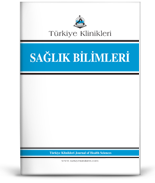Objective: This study was planned to develop a Standard scale that categorizes all employees working in the field of health and measures their professional anxiety levels. Material and Methods: In the validity and reliability process of the occupational anxiety scale for healthcare professionals, the validity and reliability method of the scale put forward by Cohen and Swerdlik was used. During the first stage of the scale development, 374 healthcare employees participated in the study and 322 healthcare employees participated in the second stage. Results: The study variance rate of this study was found to be 54.74% and the factor load values of 31 items included in the analysis were higher than 0.30. It can be observed that the chi-square/standard deviation value is 2.76, the comparative fit index is 0.85, and the adjusted goodness of fit index is 0.93. As a consequence of the items distribution, ''factor 1'' was named ''patient-centered (PAC)'', ''factor 2 ''was named ''person-centered (PEC)'' and ''factor 3'' was named ''workcentered (WOC)''. The Cronbach's Alpha values are 0.936 for the PAC sub-dimension, 0.876 for the PEC sub-dimension, 0.864 for the WOC sub-dimension and 0.945 for the total scale items. Conclusion: Conclusion: In conclusion, a valid and reliable scale consisting of 31 items was developed. According to this developed scale, the tendency for professional anxiety in healthcare professionals increases as the total mean score and that of the sub-dimensions of the scale increases. It is recommended that this scale be applied in different communities.
Keywords: Healthcare employee; occupational anxiety; scale; reliability; validity
Amaç: Bu çalışmanın amacı sağlık alanında çalışan tüm çalışanları kategorize ederek mesleki kaygı düzeylerini ölçen standart bir ölçek geliştirmektir. Gereç ve Yöntemler: Sağlık çalışanlarına yönelik mesleki kaygı ölçeğinin geliştirilmesi sürecinde Cohen ve Swerdlik tarafından sunulan ölçeğin geçerlik ve güvenirlik yöntemi kullanıldı. Ölçeğin geliştirilmesinin ilk aşamasında çalışmaya 374 sağlık çalışanı, ikinci aşamada ise 322 sağlık çalışanı katılmıştır. Bulgular: Bu çalışmanın varyans oranı %54,74 olarak bulunmuş ve analize dâhil edilen 31 maddenin faktör yük değerleri 0,30'dan yüksek çıkmıştır. Kikare/standart sapma değerinin 2,76, karşılaştırmalı uyum indeksinin 0,85, düzenlenmiş iyilik uyum indeksi ise 0,93 olduğu görülmektedir. Madde dağılımı sonucunda faktör 1'e ''hasta merkezli [patient-centered (PAC)]'', faktör 2'ye ''kişi merkezli [person-centered (PEC)]'' ve faktör 3'e ''iş merkezli [work-centered (WOC)]'' adı verilmiştir. Cronbach'ın alfa değerleri ise PAC alt boyutu için 0,936, PEC alt boyutu için 0,876, WOC alt boyutu için 0,864 ve toplam ölçek maddeleri için 0,945'tir. Sonuç: Sonuç olarak 31 maddeden oluşan geçerli ve güvenilir bir ölçek geliştirildi. Geliştirilen bu ölçeğe göre, ölçeğin alt boyutları ve toplam puan ortalaması arttıkça sağlık çalışanlarının mesleki kaygı eğilimi de artmaktadır. Bu ölçeğin farklı topluluklarda uygulanması önerilmektedir.
Anahtar Kelimeler: Sağlık çalışanı; mesleki kaygı; ölçek; güvenirlik; geçerlilik
- Şahin M. Korku, Kaygı ve kaygı (anksiyete) bozuklukları. Avrasya Sosyal Ve Ekonomi Araştırmaları Dergisi. 2019;6(10):117-35. [Link]
- Temel M, Çelikkalp Ü, Bilgiç Ş, Varol Saraçoğlu G. Hemşirelik öğrencilerinin mezuniyet sonrasina yönelik mesleki kaygıları ve etkileyen faktörler [Occupational anxiety of nursing students after graduation and impacting factors]. Anadolu Hemşirelik ve Sağlık Bilimleri Dergisi. 2020;23(1):23-34. [Crossref]
- Gudykunst WB, Nishida T. Anxiety, uncertainty, and perceived effectiveness of communication across relationships and cultures. International Journal Of İntercultural Relations. 2001;25(1):55-71. [Crossref]
- Kyriacou, C. Teacher stress and burnout: an international review. Educational research. 1987;29(2):146-52. [Crossref]
- Antony MM, Swinson RP eds. E. Bayraktar, S. Atamsoy, S. A. Giray, translations editors. Utangaçlık ve Sosyal Kaygı. 1. ed. İstanbul: Psikonet Publishing; 2021. pp.17-27.
- Shell DF, Husman J. Control, motivation, affect, and strategic selfregulation in the college classroom: a multidimensional phenomenon. Journal of Educational Psychology. 2008;100(2):443-59. [Crossref]
- Eysenck MW, Calvo MG. Anxiety and performance: the processing efficiency theory. Cognition&emotion. 1992;6(6): 409-34. [Crossref]
- Steinhardt MA, Smith Jaggars, SE, Faulk KE, Gloria CT. Chronic work stress and depressive symptoms: Assessing the mediating role of teacher burnout. Stress and Health. 2011;27(5):420-9. [Crossref]
- Cohen RJ, Swerdlik ME. Psychological Testing and Assessment: An Introduction to Tests and Measurement. 7th ed. New York: McGraw Hill; 2009.
- Dixit V, Ghosh S. Analyze impact of occupational stress in healthcare professionals: a critical review. Invertis Journal of Management. 2019; 11(1): 30-37. [Link]
- Postacı ES, Uysal İ, Koşan Aytuğ AM, Toraman Ç. Acil sağlik çalişanlari için Mesleki Kaygı Ölçeği'nin geliştirilmesi [Developing an Occupational Anxiety Scale for emergency medical service professionals]. Tıp Eğitimi Dünyası. 2020;19(58):102-15. [Crossref]
- McCarthy JM, Trougakos JP, Cheng BH. Are anxious workers less productive workers? It depends on the quality of social exchange. J Appl Psychol. 2016;101(2):279-91. [Crossref] [PubMed]
- Özdinç S, Biçici Y, Çamur M, Turan F. Fizyoterapi ve rehabilitasyon eğitimi alan lisans öğrencilerinin mesleki kaygı düzeylerinin belirlenmesi [Determination of professional anxiety levels of undergraduate students who have physiotherapy and rehabilitation education]. Yüksek Öğretim Bilim Dergisi. 2018; 8(3): 471-9. [Crossref]
- Monterrosa-Castro Á, Dávila-Ruiz R, Mejía-Mantilla A, Contreras-Saldarriaga J, Mercado-Lara M, Flores-Monterrosa C. Occupational stress, anxiety and fear of COVID-19 in Colombian physicians. MedUNAB, 2020;23(2):214-32. [Crossref]
- Tezbaşaran AA. Likert Tipi Ölçek Hazırlama Kılavuzu. 3rd ed. Mersin: e-Book; 2008.
- Büyüköztürk S, Kılıç Çakmak E, Akgün ÖE, Karadeniz Ş, Demirel F. Bilimsel Araştırma Yöntemleri. 12th ed. Ankara: Pegem Akademi; 2012.
- Tabachnick B, Fidell LS. Using Multivariate Statistics. 6th ed. Boston: Pearson; 2013.
- Can A. SPSS Ile Bilimsel Araştırma Sürecinde Nicel Veri Analizi. 2nd ed. Ankara: Pegem Akademi; 2014. [Crossref]
- Bilgin S, Yalçınöz Baysal H, Hendekçi A. Hastanede çalışan sağlık personelinin iş sağlığı ve güvenliğine yönelik görüşleri ile iş doyumlarının belirlenmesi [Determination of job satisfaction and opinion about occupational health and safety for healthcare personnel at hospitals]. Sağlık ve Toplum. 2019; 29(2): 43-9. [Link]
- Pett MA, Lackey NR, Sullivan JJ. Making Sense of Factor Analysis: The Use of Factor Analysis for Instrument Development in Health Care Re-search. 1st ed. California: Sage Publications, 2003. [Crossref]
- Gürbüz S, Şahin F. Sosyal Bilimlerde Araştırma Yöntemleri. Felsefe-Yöntem-Analiz. 3. baskı. Ankara: Seçkin Publishing; 2021.
- Çokluk, Ö, Şekercioğlu, G, Büyüköztürk Ş. Sosyal Bilimler İçin Çok Değişkenli İstatistik SPSS ve LISREL Uygulamaları. 2nd ed. Ankara: Pegem Akademi; 2012.







.: İşlem Listesi